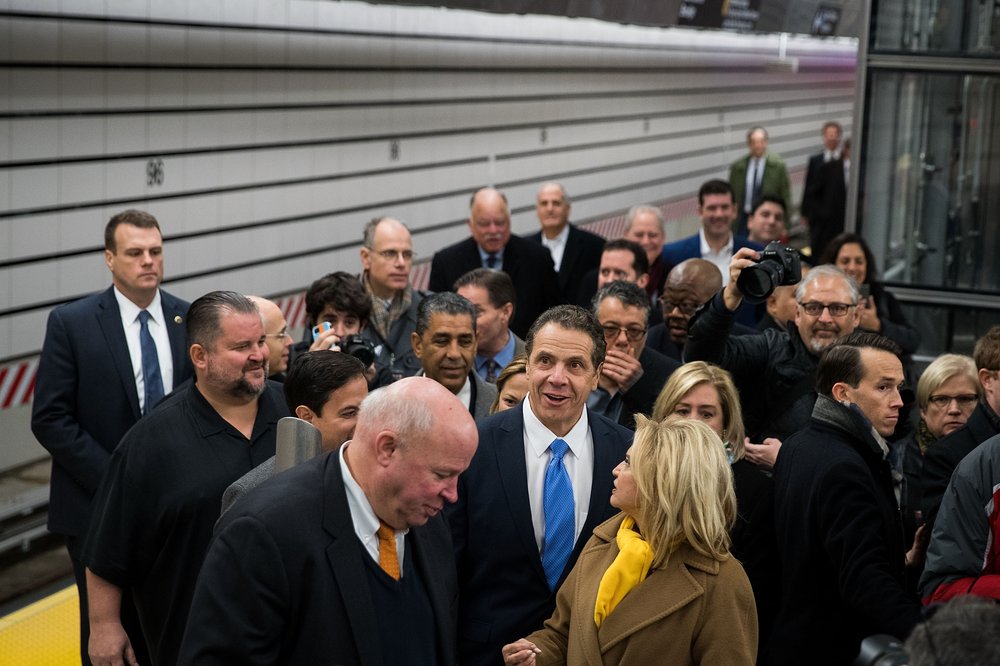Recounting Andrew Cuomo's great NYC subway fumble
June 6, 2025, 11:03 a.m.
As he campaigns for mayor, Cuomo says he can “get things done.” As governor, one of those things was terrible subway service.

Get more in your inbox
This column originally appeared in On The Way, a weekly newsletter covering everything you need to know about NYC-area transportation.
Sign up to get the full version, which includes answers to reader questions, trivia, service changes and more, in your inbox every Thursday.
Former Gov. Andrew Cuomo is campaigning for mayor on his record of using government to complete ambitious projects. “I know how to get things done,” he said during Wednesday night’s debate. He also said in an interview with the New York Times this week that “the subways have never been worse.”
Yet Cuomo’s critics say his love of big projects contributed to the problems currently plaguing New York City’s subway system.
As governor, he was in charge of the MTA when the agency deferred maintenance on crucial subway infrastructure, culminating in a record collapse of service reliability in 2017’s infamous “summer of hell.”
Transit advocates with the Riders Alliance blame Cuomo for using MTA resources to prioritize the new Second Avenue subway stops on the Upper East Side, saying it diverted maintenance from the rest of the city and caused service to collapse.
“In his lust for ribbon cuttings, he pushed forward with the Second Avenue Subway, which turned into the most expensive mile of subway ever built in the world. And at the same time, neglected daily operations for everyday riders,” said Riders Alliance spokesperson Danny Pearlstein.
Cuomo spokesperson Rich Azzopardi defended the governor’s record, and argued he’s the only governor in decades who’s completed major public works projects.
“The transit advocacy industrial complex has never been a fan, because they only like people in their own clubhouse and have no concept of what actual management entails,” said Azzopardi. “These self-appointed authorities also don’t hold a monopoly on the facts — Governor Cuomo increased MTA operating funding by $2 billion a year, passed the largest capital plan in history, increasing it 125% to $54.8 billion, and he proudly finished the Second Avenue Subway and Moynihan Train Station — two projects generations of politicians talked about but didn’t have the slightest clue how to actually build.”
Since Cuomo left office, things have changed. Gov. Kathy Hochul — while responsible for the MTA — doesn’t meddle in the agency’s operations the same way Cuomo did. She leaves the work to MTA Chair Janno Lieber (a holdover appointee from the Cuomo administration.)
As of April this year, the subway’s on-time performance was 85%. That’s not amazing, but it’s certainly not the 58% performance rate Cuomo was responsible for.
NYC transportation news this week
The e-bike crackdown. Many cyclists and a growing number of city councilmembers are calling on the NYPD to stop issuing criminal summonses to cyclists for running red lights, noting that drivers don’t face the same penalties.
As part of the broader crackdown, Mayor Eric Adams said yesterday that the city will set a 15 mph speed limit for e-bikes and scooters.
Survey says: Commuters’ perceptions of subway safety have remained high, according to riders polled by the Citizens Budget Commission — even though overall transit crime is at historic lows.
Flatbush Avenue makeover. The city’s Department of Transportation has unveiled a plan to replace two car lanes with bus-only lanes and add pedestrian islands in a notoriously gridlocked stretch of Flatbush Avenue.
Leaving Long Island. Amtrak said it wants to add Northeast Corridor train service that would run between Ronkonkoma and Washington, D.C.
Hit by bus. Police said an 87-year-old man is in critical condition after an MTA bus driver struck him in a crosswalk in Sheepshead Bay on Monday evening.
War on speeding. New York City transportation officials are urging state lawmakers to pass a long-stalled bill that would require serial speeders to have devices called speed limiters installed in their cars.
News out of Newark. The Federal Aviation Administration and Verizon have installed new fiber optic cables that should keep Newark’s radar system from going offline again.
Listen to us talk about all this! Download our app and tune in to “All Things Considered” around 4 p.m. today. And catch up on last week’s segment in case you missed it.
Curious Commuter
Have a question for us? Use this form to submit yours and we may answer it in a future newsletter!
Curious Commuter questions are exclusive for On The Way newsletter subscribers. Sign up for free here.
Question from Destiny in Queens
Why does the A train go to three different parts of Queens?
Answer
Southbound A trains can end at one of three stations, all in different parts of Queens: Lefferts Boulevard, Far Rockaway and Rockaway Park. According to the MTA, that’s because the A train is really just an assemblage of old train lines that have been expanded over time. It was first built by the Independent Subway System in 1932, stretching between Chambers and 207 streets in Manhattan. Over two decades, it slowly expanded into Brooklyn and Queens.
The Lefferts Boulevard branch was part of the elevated Fulton Street subway line that traveled all the way to Downtown Brooklyn. When the IND expanded into Brooklyn, the Fulton Street Line ultimately built a ramp on Grant Avenue that allowed for free transfers between the two. As for the Rockaway Line, that used to be operated by the Long Island Rail Road, but it was abandoned when a fire broke out on the line in the 1950s. New York City bought the line, rehabilitated the damaged tracks and eventually connected it to the Fulton Street subway at Rockaway Boulevard.
NYC mayoral hopefuls target Cuomo in first Democratic debate